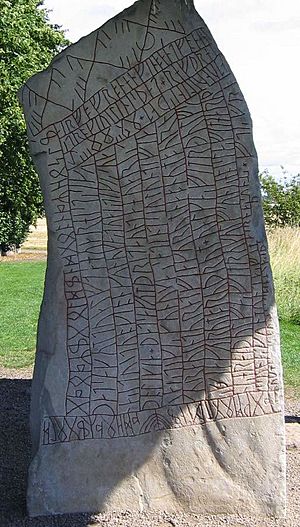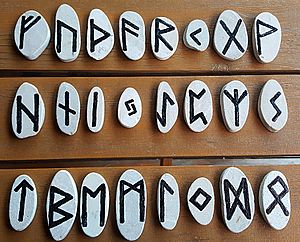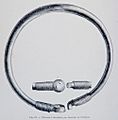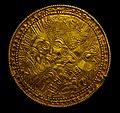Runes facts for kids
Runes are very old letters that Germanic people used a long time ago. They used them before they started using Latin letters, which happened in the Middle Ages.
The word runes usually means the special alphabets used by people in Scandinavia (like Denmark, Norway, and Sweden). They used them from about 150 CE (Common Era) until the Middle Ages.
The oldest runic alphabet is called the Elder Fuþark. People used it from about 150 to 800 CE. Around the year 800, the runes changed into the Younger Fuþark. These were used until about 1100 CE, when Latin letters took their place.
The Anglo-Saxon runes were used in Britain around the same time (400-1100 CE).
The Scandinavian runes are called "Fuþark" because their first six letters are ᚠ ᚢ ᚦ ᚨ ᚱ ᚲ. These stand for F, U, Þ (Th), A, R, K. The Anglo-Saxon runes are called "Fuþorc" because they are a bit different.
Contents
Where Can We Find Runes?
Runes are carved into stones in many places. These stones are called runestones. You can find them in Scandinavia, the British Isles, Iceland, Greenland, the Faroe Islands, and Frisia.
People used runes to write poems and special messages. Sometimes, they are still used today to write secret codes.
A famous author, J. R. R. Tolkien, used runes in his fantasy books. His stories were inspired by old Germanic mythology.
One rune, ᚦ, continued to be used in the English language for a long time. It is still used today in the Icelandic alphabet as the letter þ. It sounds like "th" in words like thing. After the Normans took over England, this letter was replaced by "th". This was because the French-speaking Normans did not know the letter þ.
Another letter, ð, also sounds like "th" (as in this). It was used in Old English and is still used in Icelandic. But this letter came from Irish, not from the runes.
What Were the Old Runic Languages Like?
When runes were first used, the Germanic languages were not split into the many languages we have today. There was one main language, called Proto-Germanic. It had different ways of speaking in different areas, like dialects.
Each rune had a name, just like our letters A, B, C have names. We don't know the exact old names of these runes. But experts have tried to figure out what they might have been. The star (*) before a rune's name means it's a guessed name.
Not all runes looked the same everywhere. Some runes and their names were different depending on the place.
Rune Alphabets Compared
Here is a table showing some of the runes. It compares the Elder Fuþark, Younger Fuþark, and Anglo-Saxon Fuþorc. It also shows what modern letter or sound they stand for.
| Runes | ||||
|---|---|---|---|---|
| Name | Elder Fuþark | Younger Fuþark | Anglo-Saxon Fuþorc | Transliteration |
| *fehu | ᚠ | ᚠ | ᚠ | F |
| *ūruz | ᚢ | ᚢ | ᚢ | U |
| *thurisaz | ᚦ | ᚦ | ᚦ | þ (th) |
| *ansuz | ᚨ | ᚬ ą | ᚩ o | A |
| *raidō | ᚱ | ᚱ | ᚱ | R |
| *kaunan | ᚲ | ᚴ | ᚳ c | K |
| *gebō | ᚷ | ᚷ ȝ | G | |
| *wunjō | ᚹ | ᚹ | W | |
| *haglaz | ᚺ | ᚼ | ᚻ | H |
| *naudiz | ᚾ | ᚾ | ᚾ | N |
| *īsaz | ᛁ | ᛁ | ᛁ | i |
| *jēra | ᛃ | ᛄ | J | |
| *eihwaz | ᛇ | ᛅ a | ᛇ eo | ï / ǣ |
| *perþ | ᛈ | ᛈ | P | |
| *algiz | ᛉ | ᛉ x | Z | |
| *sōwilō | ᛊ | ᛋ | ᛋ | S |
| *tīwaz | ᛏ | ᛏ | ᛏ | T |
| *berkanan | ᛒ | ᛒ | ᛒ | B |
| *ehwaz | ᛖ | ᛖ | E | |
| *mannaz | ᛗ | ᛗ | M | |
| *maðr | ᛘ | M | ||
| *laguz | ᛚ | ᛚ | ᛚ | L |
| *ingwaz | ᛜ | ᛝ | ŋ (ng) | |
| *dagaz | ᛞ | ᛞ | D | |
| *ōðala | ᛟ | ᛟ œ | O | |
| — | ᛦ | ʀ | ||
| — | ᚪ | a | ||
| — | ᚫ | æ | ||
| — | ᚣ | y | ||
| — | ᛠ | ea | ||
Images for kids
-
A carving using secret runes, Elder Futhark, and Younger Futhark. It's on the 9th-century Rök runestone in Sweden.
-
A clog almanac from the 1600s. It was collected by Sir Hans Sloane and is now in the British Museum.
-
Marcomannic runes.
-
Runic writing on an 1886 gravestone in Parkend, England.
See also
 In Spanish: Alfabeto rúnico para niños
In Spanish: Alfabeto rúnico para niños
















